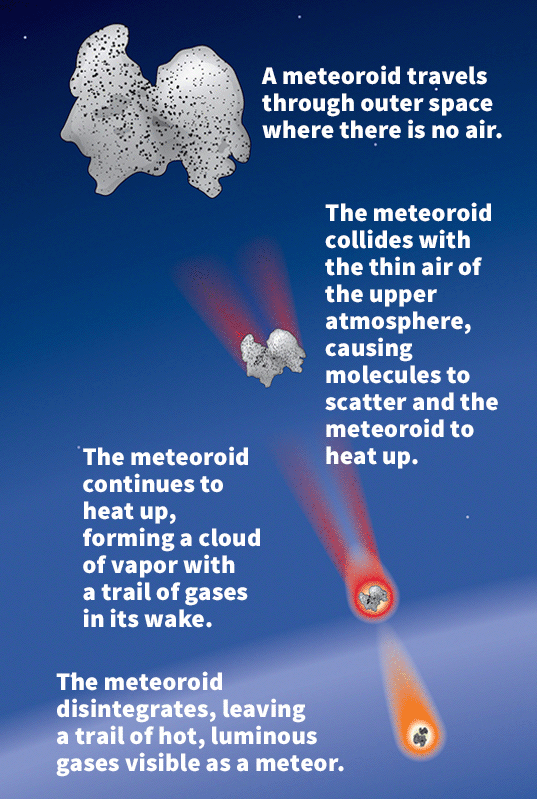Feb. 21-27, 2013, Current Events Lesson Plan
Current Event:
The unexpected explosion of a meteor over Russia injured more than 1,000 people and shattered windows, dishes, and television screens over a large area near the city of Chelyabinsk in western Siberia. Most of the injured were hurt by flying glass. Preliminary reports said the blast also damaged nearly 300 buildings, including 12 schools and 6 hospitals. The meteor was originally estimated to weigh about 10 tons (9 metric tons). However, NASA later estimated that the meteor weighed closer to 10,000 tons (9,000 metric tons). The meteor was not related to an asteroid that made a close approach to Earth on the same day.

A meteor appears in the sky when an object called a meteoroid enters the atmosphere from space. World Book illustration by Greg Maxson
Objective:
A meteor is a streak of light that appears in the sky. A meteor appears when a piece of matter enters Earth’s atmosphere from space at a high speed. Such a piece of matter is called a meteoroid. As the meteoroid collides with the air, it is heated so that it glows, creating a shining trail of hot gases. Most meteors burn up in the atmosphere and never reach Earth. Other meteors, like the one in Russia, break into fragments that fall to Earth. Rarely, large meteors strike the Earth and produce craters. One of the most famous craters, Meteor Crater in Arizona, is about 4,180 feet (1,275 meters) across and 570 feet (175 meters) deep. If a meteoroid travels too fast, it may explode before reaching Earth’s surface. One such object exploded about 5 miles (8 kilometers) above the Tunguska River in Siberia in 1908, leaving an area roughly 31 miles (50 kilometers) in diameter of felled and scorched trees. The Behind the Headlines news story and related World Book articles explore meteors and other astronomical topics.
Words to know:
- Asteroid
- Astronomy
- Comet
- Fireball
- Meteor
- Meteoroid
- Meteor Crater
- NASA
- Russia
- Siberia
- Sonic boom
Discussion Topics:
1. Ask your students the difference between the terms “meteoroid,” “meteor,” and “meteorite.” (A meteoroid is a small body, often from a comet, that travel through space and become meteors or shooting stars when they enter the earth’s atmosphere. A meteor is a streak of light that appears when a meteoroid enters Earth’s atmosphere and vaporizes. A meteorite is a meteoroid that reaches Earth’s surface intact.)
2. A meteoroid is a celestial body that orbits the Sun. Ask your students if they know any other types of celestial bodies that orbit the Sun. (They might say the 8 planets; 5 recognized dwarf planets, including Pluto; comets, such as Halley’s Comet; asteroids.)
3. Have your students debate the topic, “The U.S. should invest money in a weapon that could destroy any meteoroid that might hit Earth.”
4. Ask your students to use the World Book’s Timelines feature to create a timeline of important astronomical discoveries. (Your students may wish to use the “History” section of World Book’s Astronomy article to help them make their timeline.)


